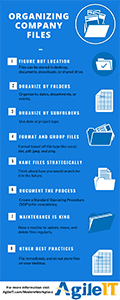With thousands of images, documents, and videos, the importance of a reliable way to organize company files cannot be overstated. A recent report reveals that employees spend 1.8 hours daily - 9.3 hours weekly - searching for information. This is a waste of precious time that could be used in more productive tasks that improve your business’ bottom line.
You can reduce the amount of time used to retrieve company files by investing in proper file organization. Good organization of files provides usability and affects the integrity of data.
However, there is no single correct method for organizing your business files. The secret is to figure out a system that works for your organization. This article explains seven best practices for organizing company files.
1. Figure Out Location
Click to view the infographic[/caption]
The first step in organizing your files is figuring out where they are located and consolidating them. The files can be in your desktop, documents, downloads, or shared drive. If you are using Microsoft 365, it is best practice to keep your files in SharePoint. SharePoint offers a platform for managing ‘content, knowledge, and applications.‘
Also, Office 365 provides an array of ways to find the documents you need quickly. Whether a colleague shared the document with you or it is stored in OneDrive for Business, you can find it seamlessly. Figuring out the location of different files can be a labor-intensive and time-consuming process. However, it is a worthy process to achieve efficiency in the long-term.
2. Organize by Folders
Do not leave your company files scattered all over your computer. Instead, organize them in folders based on dates, departments, or events. For example, if you had a recruiting mix, you can save all documents, photos, and videos related to the event under a folder named Recruiting Mix February 2020.
Do not forget to decide on the best folder structure for your organization. You can structure the folders depending on projects/clients, dates, or file-type. It is best practice to choose a structure that suits the way you work, and everyone is comfortable with it. Also, do not merge business and family files unless they overlap. You can use folders to separate the two; create two-parent folders, one for ‘business’ and another one for ‘personal’.
As you organize your data in folders, do not over-create folders. Think minimal. Only create new folders when necessary –when you repeatedly save similar files in one place. Creating too many folders will make filing and retrieving data daunting and overwhelming.
3. Organize by Subfolders
Subfolders help you to find data quickly and effortlessly. When folders are divided into subfolders, you can zero in on what you want to find. For example, you can have a folder named 2019 Finances, then a subfolder for invoices containing invoices for different months. Do not forget to have a consistent way of organizing your subfolders. You can use the date or project type.
4. Format and Group Files
 It is best practice to arrange files based on their formats like excel, doc, pdf, jpeg, and ping. This way, retrieving files will be easier and painless. For instance, if you want to retrieve your last meeting’s minutes, you don’t have to navigate through pdfs and excels. Instead, you just search the file by format.
It is best practice to arrange files based on their formats like excel, doc, pdf, jpeg, and ping. This way, retrieving files will be easier and painless. For instance, if you want to retrieve your last meeting’s minutes, you don’t have to navigate through pdfs and excels. Instead, you just search the file by format.
5. Name Files Strategically
One of the goals of organizing your company files is making them easy to find. Among the ways of accomplishing this is naming your files and folders strategically. It doesn’t have to be complicated. A good way of naming files is keeping in mind the ‘future you’. When storing a document, think about the circumstances you will need it for in future and what words you might use while looking for it.
For instance, when naming a phone bill, think about how you would search for it in the future. Probably, you will search for it by date. Therefore, an ideal way to name it is by date. For instance, the September phone bill.pdf is great.
It is best practice to use a descriptive file name so that you know a file’s contents before opening it. Avoid using abbreviations for your files because they can confuse you. You may think that you will remember an abbreviation, but there are high chances of forgetting it. Think about a project name, report title, or date.
6. Document the Process
After developing a definitive way of organizing your corporate files, the last step should be to document the process. Most firms have a formalized standard of crafting new processes called Standard Operating Procedures (SOP’s). After spending time and resources organizing your company files, you want to guarantee consistency in the future. Therefore, documenting the file organization process becomes crucial.
7. Maintenance Is King
Organizing your files is not a one-off process; it is a continuous process. Take time to go through your files regularly to remove files that are no longer needed. If you have a folder for current projects, you have to update it weekly to get rid of completed projects.If you make maintenance a routine, you may find that you don’t have files to be moved or deleted.
Other Best Practices
- Don’t store files on your desktop: This looks messy and cluttered.
- Skip the downloads folder: Instead, store files where they belong or delete them.
- File immediately: Do not wait for files to pile up to file them. Do it as soon as you create or receive a file.
- Search is powerful: If you can’t find a file you are looking for, consider the search feature. It will be helpful if your files and folders are named correctly.
- Don’t give up so fast: It takes a little time and effort to adapt to something new. Don’t give up on organizing your files yet.
Learn More About Organizing Company Files
Keeping your company files organized is a fundamental part of being organized. Don’t waste time and energy digging around for a document. Use the best practices listed in this article to organize your company files and locate documents in five seconds, not five minutes or hours. Also, organize your corporate files in a modern workplace today. Agile IT provides security and compliance solutions to protect your data within the cloud. To get started, schedule a call today.
Published on: .
